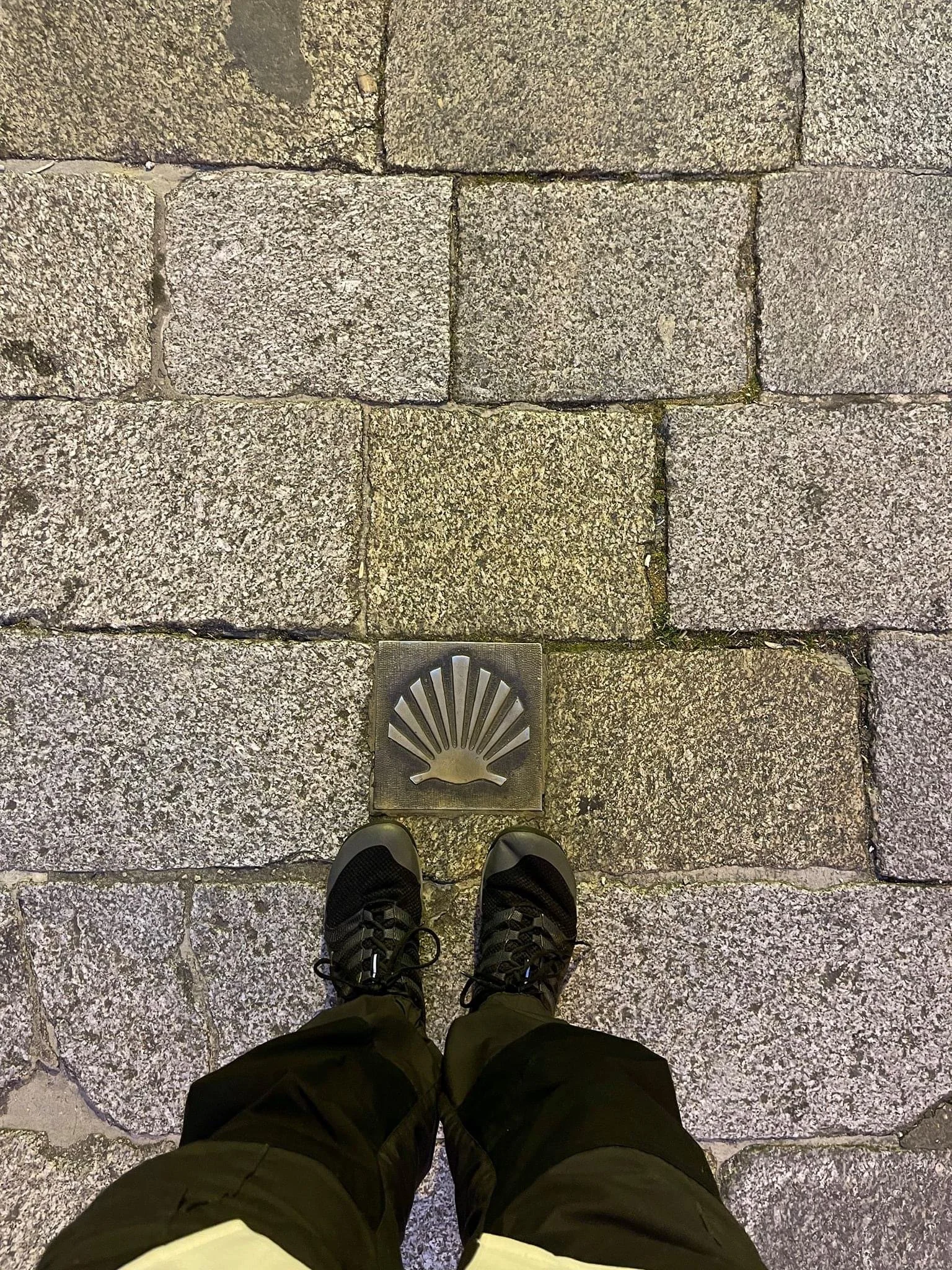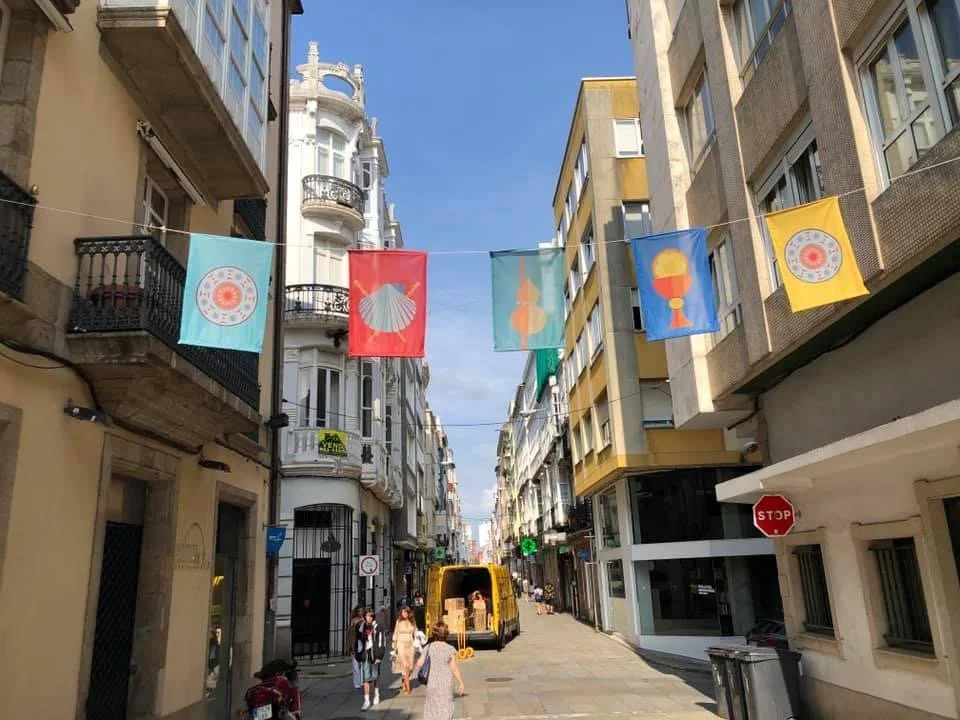Nashotah House Alumni Reflect on the Camino Inglés to Santiago
Nashotah House alumni, Tom Heard (‘17) and the Rev. James Brzezinski (‘12) walked the Camino de Santiago this past summer. This was the third pilgrimage for Heard and the first for Brzezinski.
“Much of the camino is about community and pilgrimage,” says Heard. “Everyone is essentially hiking at the same speed, so you find yourself striking up a conversation, but you’re also alone much of the hike, which allows for time in prayer and reflection. When you’re on pilgrimage, you find yourself getting to know a lot of people and after a while, you form something of a family of pilgrims.”
Created and established after the discovery of the relics of the Apostle James at the beginning of the ninth century, the Way of St. James became a pilgrimage route for medieval European Christians from the tenth century onward. Still a life-changing experience for many throughout the world, the hike continues to be full of enchanting landscapes and diverse people, with a number of terrific breakfasts and scenic villages along the way.
In 1987, the Camino de Santiago, was declared the first Cultural Route of the Council of Europe. Around 350,000 Compostela pilgrim certificates were issued in 2019 alone (compared to just over seven in 1976). Today, people from over 190 different countries--and of all ages and nationalities--make the journey along this UNESCO-listed trail every year. There are many different routes along the camino, including the Camino Inglés and the Camino Francaise.
When choosing a route, travel guides tend to recommend trying to aim for walking at approximately 60 miles (10 km) per day. Both the French Way and the English Way are extremely popular. The last 100 km take around six days to walk for most people, while the entire French Way takes around 35 days to walk.
A common sight is the scallop shell and the cross of St. James, which are either worn by pilgrims or attached to their backpacks.
“The Camino is symbolic of the Christian faith: our entire lives are a pilgrimage, and the hike mirrors a sense of movement with the journey we are on in life and gives us a challenge, a new awareness of ourselves and our relationship with the Lord,” says Heard.
Whether walking through valleys or hiking steep terrain, Fr. Brzezinski says the trek is physically demanding, and it challenged him to consider how he spends time in his regular daily life.
“Faith is dynamic, and worshipping God is never passive,” he says. “Walking and praying at the same time had quite an effect on me and allowed me to consider how much we can waste time with life’s distractions.”
Participating in the Ignatian prayer method over the years enabled Heard to consider walking the camino following the pilgrim route taken by St. Ignatius of Loyola, where Ignatius likely walked in 1522.
“The camino is strenuous if you are not normally physically active,” says Brzezinski. “It can be tedious; terrain can be rough, the hills are significant, and you do need to be prepared for rain. However, it is a holy place and the walk has always been intended to be penitential.”
Will they consider a pilgrimage again soon? Brzezinski says definitely and Heard has plans in the works for the 500th anniversary of Ignatius of Loyola, which begins at the birthplace of Ignatius in Spain’s Basque country, in a village near the small town of Azpeitia. From there, the route proceeds for hundreds of miles.
A typical traveling day is packed with many additions as well. Brzezinski noted in his journal one such day:
At the camino, [we] took a quick taxi to visit the city of Coruña. Walking tour by the port, then a stop for a cerveza for quick refreshment; very brief visit at St. Thomas Church. More walking, then a visit to the Tower of Hercules, where we received another stamp on our credential for the camino. Walked by another church which was not open. Refreshment stop for Manchego cheese and chorizo Salamanca. Taxi ride back to Ferrol. Siesta and prep for tomorrow’s camino walk from Ferrol to Neda. Attending Mass this evening at 7:00 p.m., followed by dinner at Casa Maruxa again this evening at 8:00. A great day of relaxation and training for walking the camino.
“People would literally try to walk off their sins,” says Heard. “This year is considered a jubilee year, and after Covid lockdowns, illnesses, and many challenges, people seemed truly overjoyed as they were on the path with Jesus.”
Camino Inglés
The English Way
Itinerary
1 September 2021 | Fr. Brzezinski - Chicago O’Hare International with short stopover in Madrid, Spain, on to A Coruña, Spain, cab ride to Ferrol, Spain, arriving on 2 September 2021
2 September 2021 | Ferrol, Spain - meet fellow peregrino (pilgrim), Thomas Heard.
3-4 September 2021 (Day 1) | Ferrol – free time to adjust to new time zone and for prayer
5 September 2021 (Day 2) | Walk to halfway point, TBC, taxi back to Ferrol: 10 miles | 21 km
6 September 2021 (Day 3) | Taxi back to halfway point, finish walking to Cabanas or Pontedeume: 10 miles / 21 km
7 September 2021 (Day 4) | Cabanas to Betanzos: 13 miles / 21 km
8 September 2021 (Day 5) | Walk to halfway point, taxi back to Betanzos: 11 miles / 21 km
9 September 2021 (Day 6) | Taxi back to halfway point, finish walking to San Paio de Buscás: 11.5 miles / 18 km
10 September 2021 (Day 7) | San Paio de Buscás to Marantes: 16 miles / 26 km
11 September 2021 (Day 8) | Marantes to Santiago de Compostela: 7.65 miles / 12 km
12 September 2021 (Day 9) | Santiago – Attend Pilgrim’s Mass
13 September 2021 | Free day plus return to A Coruña, Spain
14 September 2021 | Onward Travel - A Coruña, Spain, to stop over in Madrid, Spain, to stop over at London Heathrow, to Chicago
The Rev. James Brzezinski serves as rector of St. Anne’s in Morrison, Illinois, where he and his wife, Nancy, enjoy welcoming people into an ever-deepening relationship with Jesus Christ in the Anglo-Catholic tradition. As a cradle Episcopalian who grew up in New England, during his youth he sang in the Royal School of Church Music – Men and Boy Choir training program in his parish. He operated his own business making organ pipes for other pipe organ builders. After closing his organ pipe shop, he worked for the citrus processing company where his father-in-law was CEO. He assisted in managing the domestic and international logistics of shipping frozen concentrated orange juice. Feeling the call to priesthood, he returned to college and completed his Bachelor of Business Administration degree at Belhaven University. He spent three years as a seminarian at Nashotah House and earned the Master of Divinity Degree.
The Rev. Tom Heard is from the hills of Appalachia, who grew up in the Episcopal Church in West Virginia. His educational aspirations eventually led him to a doctorate in Biochemistry, to which he did postdoctoral work at Merck in Rahway, NJ, and then at the NIH, in Bethesda Maryland. His interest in theology and apologetics grew to where he became a Fellow and a Teaching Fellow at the C.S. Lewis Institute in Washington D.C., and a Colson Fellow at PFM, as well as studying apologetics in Oxford, England in many OCCA summer schools. Prior to his time at the NIH, he read a book on the Ignatian Exercises which sparked an abiding interest in Ignatian spirituality. After completing the Exercises in 2011, providence would have it that an apprenticeship opened up some ten months later, and he completed the studies, both theory and practicum, at the Loyola Retreat House in Falkner, Maryland. He has taken many participants through the journey in the Exercises and lectured on Ignatian Spirituality. Tom graduated from Nashotah House with a M.Div. equivalency in 2017 with an emphasis in ascetical theology, and then went on to a Master’s in Classics and Christian Studies at Knox. His first Camino was from Loyola, Ignatius’ home, to Monserrat, and then to Manresa where Ignatius wrote the Exercises. In that 28 day walk, he redid the Exercises again with the other pilgrims under the guidance of Fr. Joseph Iriberri, SJ. In 2022, Tom will walk the Camino Ignaciano again to arrive in Manresa March 25th, the day Ignatius arrived 500 years before in celebration of his Jubilee year.




